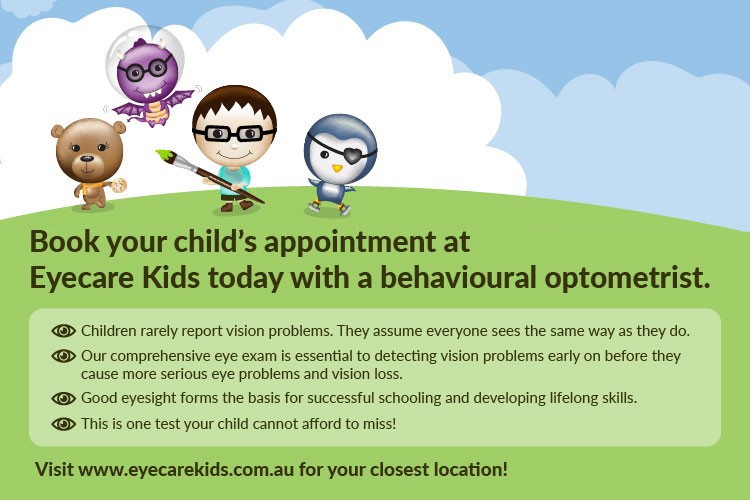It’s well known that a large component of learning in the classroom goes through the visual system. Students need to understand what they are seeing, be able to direct their attention appropriately in the classroom and not be distracted, remember that they are seeing, be able to copy from the board, recall sequential information such as spelling words and be able to visualise what they read.
So it is very important to provide clear and comfortable vision for school age children in order to support their learning. According to Prevent Blindness America, one in every four school-going children have vision problems that if left untreated can affect learning ability, personality and adjustment in school. What’s even more concerning is that at least 80% of students attend school without having had an eye exam from an optometrist.
As the late Prof Brien Holden from the Brien Holden Vision Institute and the Vision for Life stated, “Every 7 year old child when going to school should take along a certificate from an optometrist that says, ‘I’ve had my eyes tested, I can see’. Every 11 year old going to secondary school should do the same.”
Seeing clearly for distance (also understood as 20/20 sight) is not the only measure for good vision. Our optometrists have put together the 10 Most Common Signs that all teachers and parents should be aware of that may indicate a vision problem in a child attending school
Consistently sitting too close to the TV or holding a book too close
Losing their place while reading or using a finger to guide their eyes when reading
Squinting or tilting the head to see better
Frequent eye rubbing
Sensitivity to light and/or excessive tearing
Closing one eye to read, watch TV or an ipad
Avoiding activities which require near vision, such as reading or homework
Complaining of headaches or tired eyes
Avoiding using a computer, because it “hurts their eyes”
Not achieving their academic potential
These signs can help our behavioural optometrists to diagnose if there is an underlying vision problem that is affecting the student in the classroom. For many parents and teachers, this is a hidden problem that shows up as behavioural issues. So here is a quick summary of what these signs could potentially indicate:
Myopia and Astigmatism
- Blurry vision for distance makes it harder to pay attention at the board
- The most common type of refractive error is myopia (up to 31% now in school age children in Australia)
- Warning Signs: Squinting when trying to look at the board
Strabismus
- Strabismus is also known as an eye turn due to a coordination difficulty
- 3-5% of children have strabismus so there a good chance there is one in every classroom
- Sometimes strabismus is not as obvious as you think, so be aware of the warning signs!
- Warning Signs: eye turning in or out, an unusual head turn or tilt, covering an eye to see, no 3-D vision and double vision
Amblyopia
- Amblyopia is also known as a lazy eye and commonly also found in children with eye turns
- This means one eye sees clearly but the other eye sees blurry even with glasses on
- Warning Signs: Children with amblyopia usually do not show any signs or symptoms and they can go undetected for years until they have an eye test.
Eye allergies
- Sensitivity to environmental allergens such as pollen and dust.
- 18-20% of children suffer from eye allergies and it can make life miserable for the child and the parent!
- Constant rubbing of the eyes can create other vision problems in the future. So no eye rubbing!
- Warning Signs: Watery and itchy eyes accompanied by rubbing of eyes. Sometimes a seasonal pattern may be observed with symptoms increasing during spring and summer.
Focusing Problems
- Focusing problems are a bit like having a poor macro lens on your camera. Getting the right focus can be hard work!
- This can sometimes show up as a reading problem or an attention difficulty
- Warning Signs: Child holding things too close to see, complain about sore eyes when reading or might not complain at all but will avoid near work
Convergence Insufficiency
- Around 12% of children have convergence insufficiency and it’s as common as focusing problems.
- It’s usually a type of eyestrain difficulty and it makes the words look like they are unstable or moving around
- Warning Signs: Similar to focusing problems with near activities but they may also complain about double vision if it’s bad enough
Eye Tracking Difficulties
- An eye tracking problem usually shows up as someone who can’t keep their eyes on the page when reading
- A behavioural eye exam can tell you WHY there is a tracking problem and what the underlying difficulty might be
- Could be due to eyestrain, strabismus, amblyopia or simply a developmental delay in their ocular motor skills
- Warning Signs: skipping words or lines when reading beyond the age of 7-8 and/or excessive head movements
Visual Memory
- The ability to see clearly is not enough in the classroom
- Being able to recall what you can see and understanding what you see are just as important
- These are part of the visual processing skills a child also needs to develop in the early years
- Warning Signs: difficulty with sight words and recalling visual information

